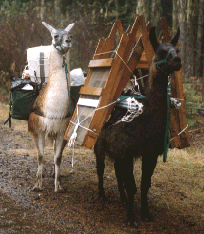Llama care, management and resources
- Llama FAQ
- Llama literature
- Basic care
- Castration
- Spaying
- About breeding llamas
- Handling young llamas
- Misdirected territorial aggression
- How old should llamas be for training and work?
- Selecting a llama pack
- Packing with females
Fiber from llamas
Llamas
as guardians
Classic performance llamas
Communicating
Our llama family
Just for fun
Cria photos
Training consultation
Performance
llama analysis
If you don't rescue ... DON'T BREED!
Selecting a llama pack system
There are a number of considerations in selecting a llama pack system. Some are only personal preference, but some are critical to the wellbeing of your llama. It is not unusual for a llama to tolerate an ill-fitting saddle until irreversable damage has been done, or even longer. It is also not unusual for a different llama to be a poor (or intolerable) packer, only to become a willing trail partner once pack saddle problems have been corrected. A well-fitting pack saddle is important to all llamas.
The basic criteria from your llama's viewpoint are:
- Free of spinal contact and pressure
- Free of contact or pressure on moving parts
of the llama's body
- The entire system stays in place during use
- No parts that dig in (many saddles stay in
place only because they dig into the llama)
- Adequate contact area (so that circulation
is not impaired)
- The impact of both normal travel and jumping is absorbed by the system, not the llama
A fully detailed treatise of the subject, including how to fit a saddle to your llama and use it successfully, would take up more room than we have alloted to us for this website! However, Gwen has authored an affordable, comprehensive booklet, Evaluating a Llama Pack for Comfort and Function, which you can order from Lost Creek Llamaprints.
Unlike manufacturer's information and some mail-order house leaflets, Evaluating a Llama Pack for Comfort and Function does not tell you which pack to buy, nor does it recommend specific pack saddles or systems, nor does it list positive (but no negative) features of pack systems that are available. Pack saddles and systems are constantly being changed -- both for better and for worse. Instead, this comprehensive booklet tells you what features and functional aspects to look for before you buy, and it also shows you how to look for it -- on your own llama. So, no matter what pack system you're looking at, you'll always be able to make a sound decision for yourself and the comfort of your llama.
In addition, Gwen and Ranger Dusty have evaluated many of the llama pack saddles currently available. The complete reviews can be found in back issues of The Backcountry Llama. To date, three llama pack systems (listed in alphabetical order) have met the established criteria (above):
- Flaming Star Pack System (review published August 1993)
- 1996 Sopris Lumbar Pack System (review published October 1997)
- 1996 Sopris Pack System (review published August 1996)
Critical information about fitting and using a llama pack system is also found in Evaluating a Llama Pack for Comfort and Function.

Photo at right: 100+ pounds of archeological screens and a canopy frame on Dusty (foreground) and 70+ pounds of bulky, additional support gear on Sydney (rear) were packed out two miles over very steep "way trails." Carrying these kinds of loads successfully requires a great deal of knowledge, good pack systems, and good pack llamas.
Author Gwen Ingram has extensive experience since 1986 packing with llamas under highly demanding conditions, including distance packing (continual 20+ mile days), heavy load hauling (up to 120 lbs payload per llama), and contract packing unusual and awkward loads for varied clients, including the USFS. She has also provided successful consultation for innumerable llama packers and their highly varied pack llamas over the years.
Return to: Care, Management, and Resources
Return to Lost Creek Llamas home page